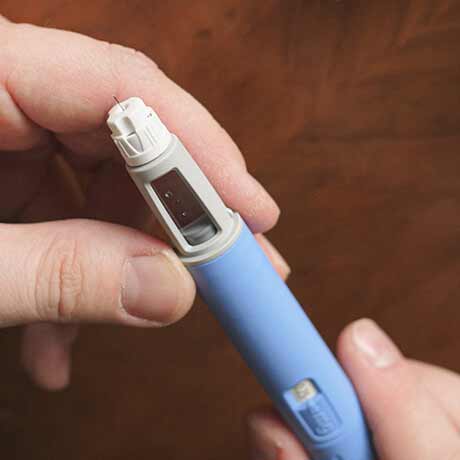- Private & confidential service
- Genuine medication
- All-inclusive service - No hidden fees
- Next day delivery
- Weight Loss
- A guide to prescription weight loss treatments
- Ozempic weekly injection pen
Ozempic weekly injection pen
Everything you need to know about the weekly injection pen Ozempic (Semaglutide)
Ozempic is a highly popular and successful medication, used globally in 75 countries, demonstrating its widespread trust and popularity among people.
In this article we cover what Ozempic is, its uses, recommended dosages, and how to administer it. Keep reading to understand the factors contributing to its worldwide recognition.
What is Ozempic?
Ozempic, containing the active ingredient Semaglutide, is a prescription medication used to treat type 2 diabetes mellitus (T2DM). Although it is used for diabetes management, it has been found to cause weight loss as a side effect.
Ozempic should be used with a balanced diet and regular exercise when prescribed.
What is Ozempic (Semaglutide) used for?
Ozempic is a medicine that helps people with type 2 diabetes. The active ingredient, Semaglutide, helps keep blood sugar levels in the right range.
Studies showed that people using this medicine often lost weight as a side effect.
A new medicine called Wegovy, also containing Semaglutide, is now available in the UK. Semaglutide, sold under the name Wegovy, is specifically licensed and used for weight loss, not diabetes.
What is the difference between tablets and injections?
Semaglutide is available as injections as well as tablets. Semaglutide tablets are available under the brand name Rybelsus. They work in the same way but have several advantages over injection pens:
- you only take 1 tablet once daily
- you don't need to use an injection
- they are easy to store - tablets do not need to be kept in cool conditions like the injections do
How does Ozempic work?
Semaglutide, the active ingredient in Ozempic, increases the levels of a hormone called GLP-1. This hormone helps to control blood glucose levels and how much you want to eat.
It works in 3 different ways to lower your blood sugar levels:
- It helps an organ called the pancreas make more insulin (insulin is the hormone that controls the amount of sugar in your blood) when your blood sugar levels are high.
- It reduces the amount of sugar that your liver makes and releases.
- It slows down the rate at which food leaves your stomach, so it takes longer for your body to absorb the sugar from your food.

Semaglutide is a GLP-1 analogue and belongs to the same group as Liraglutide (Saxenda). It increases GLP-1 levels. Doing so causes your stomach to empty and digest food more slowly after eating. This reduces your appetite and leaves you feeling fuller for longer.
How much weight can I lose on Semaglutide?
In 2021, a study in the New England Journal of Medicine tested how well Semaglutide can help with obesity.
They monitored the progress of 1961 adults for 68 weeks. Half took a placebo, an inactive drug believed to be the weight-loss drug, and the other half took Semaglutide.
They found that those who took the Semaglutide had a 14.9% loss in body weight when combined with a healthy diet and exercise, compared to those who took the placebo and lost 2.4% of their body weight. This is a significant difference and success.
Learn how Semaglutide causes weight loss
Can I buy Ozempic for weight loss?
No. In the UK, Ozempic is only approved for treating type 2 diabetes, not weight loss.
However, as of February 2022, the National Institute for Health and Care Excellence (NICE) in the UK has endorsed the use of Semaglutide, under the brand name Wegovy, for obesity treatment. This recommendation means Wegovy is now officially licensed for weight loss, and other Semaglutide medicines should no longer be prescribed off-label for weight loss.
This is why Ozempic is used for type 2 diabetes management.
What dosage should I take?
Ozempic is available in 3 dosages: 0.25, 0.5 and 1mg. The doses can be differentiated based on the colour label of the pen.
- 0.25mg - grey-label pen
- 0.5mg - red-label pen
- 1mg - blue-label pen
The starting dose of Ozempic is 0.25mg. Once stable on that dose for 4 weeks, it can be increased to 0.5mg.
You can then be prescribed the 1mg dose after 4 weeks of being stable on the 0.5mg dose. Some people need the 1mg dose, whereas others may only require a 0.5mg maintenance dose.
How do I change from Ozempic to Wegovy?
If transitioning from Ozempic to Wegovy, you must know what dose to take.
Up until 1mg, the doses are identical. This means you can easily transition from Ozempic to Wegovy during this time.
For instance, if you are taking or have recently taken the 0.25mg Ozempic pen, you can switch to the 0.25mg Wegovy pen or up to the 0.5mg if you have finished the 4-week course.
How do I administer Ozempic?
Semaglutide should be administered once weekly, preferably on the same day and time each week. However, if you have to change the day you take it, you can as long as your last dose was at least 2 days prior.
You can inject it at any time of day, regardless of meals.
Where to inject Ozempic
When using Semaglutide, inject it into your thighs, lower belly, or upper arm. Make sure to change where you inject each time so your skin does not get irritated.
How to inject an Ozempic pen
A short guide on how to inject it is as follows:
Prepare the pen and needle
|

|
Place the new needle
|

|
Check the flow
|

|
Select the dose
|

|
Inject the dose
|

|
The patient information leaflet provides a thorough guide with instructions and diagrams. A physical copy is supplied with your medication, or you can download it on the left of this page.
What should I do if I forget to take my Ozempic?
- What you need to do will depend on how long it has been since your last dose.
- If it has been less than 5 days, take the missed dose as soon as you remember. Take your next dose at your normal time.
- Do not take the missed dose if it has been 5 days or more. Skip it and take your next dose at the usual time.
If you have missed 2 or more consecutive doses (at least 14 days), you can resume the dosing schedule or lower the dose if needed.
Do not take a double dose of Semaglutide. Too much Semaglutide can cause dangerously low blood sugar levels (hypoglycaemia).
How do I store Ozempic pens?
An unopened Ozempic pen must be kept in the refrigerator between 2°C - 8°C. Your pen will be delivered in insulated packaging to ensure it stays cold.
Once opened, you can keep the pen in the refrigerator or at temperatures below 30°C.
Keep your pens away from a direct heat or light source, and keep the lid on the pen.
Storing your pen correctly will prevent the solution inside from becoming cloudy or discoloured. Regularly check that the liquid is clear and colourless. If it is cloudy or discoloured, discard the pen.
How do I dispose of Ozempic pens?
You must throw away needles into the sharps bin that your prescriber has provided. Once it is full, you can contact your local council, and they will collect it.
The pen can be given to your local pharmacy, which will have dedicated clinical waste disposal facilities.
Do not throw any needles or medication with your household waste.
What are the possible side effects?
As with most prescription medications, Ozempic can cause some side effects. However, the most common side effects are mild and temporary.
Common side effects include:
- feeling sick (nausea)
- being sick (vomiting)
- diarrhoea
- indigestion
- acid reflux and heartburn
- inflammation of the stomach (gastritis)
- stomach cramps
- tiredness
- dizziness
- loss of appetite
Because it affects blood sugar levels, it can cause hypoglycaemia, which is when your blood sugar levels drop too low. It is more likely to occur if you take Ozempic together with other medications for diabetes.
You may have hypo If you experience any of the following symptoms:
- pale skin
- cold sweat
- feeling nervous, anxious, or confused
- feeling sick and/or starving
- vision changes
- feeling sleepy or weak
- difficulty concentrating
- shaking
Please consult the patient information leaflet for a comprehensive list of side effects.
Who can take Semaglutide?
Ozempic is prescribed along with diet and exercise to improve blood sugar levels in adults with type 2 diabetes. It is also used to reduce the risk of major cardiovascular events such as heart attack, stroke, or death in those with both type 2 diabetes and heart disease.
This medication is not suitable for:
- women who are pregnant or breastfeeding
- those with type 1 diabetes or diabetic ketoacidosis
- those who are allergic to Ozempic or any of the other listed ingredients
Other groups of people can take Semaglutide but may require additional monitoring from their doctor while using it, including those who:
- are taking insulin or other diabetes medications
- are being treated for diabetic retinopathy
- are taking warfarin to reduce blood clotting
- have a history of pancreatitis (inflammation of the pancreas)
- have or have had severe congestive heart failure
If you need clarification on whether you fall under these categories or have other medical conditions, consult your GP or healthcare provider before taking Semaglutide.
Further reading

A guide to prescription weight loss treatments Wegovy interactions: what you need to know
Reviewed by Dr. Plauto Filho
A guide to prescription weight loss treatments 5 ways to increase weight loss on Wegovy
Reviewed by Dr. Plauto Filho
A guide to prescription weight loss treatments Side effects of Liraglutide and how to manage them
Reviewed by Dr. Plauto Filho
A guide to prescription weight loss treatments Semaglutide: what to expect and when
Reviewed by Dr. Plauto Filho
A guide to prescription weight loss treatments Semaglutide side effects: what you need to know
Reviewed by Dr. Plauto Filho
A guide to prescription weight loss treatments What semaglutide dose should I take?
Reviewed by Dr. Plauto Filho
A guide to prescription weight loss treatments An introduction to GLP-1 agonists for weight loss
Reviewed by Dr. Plauto Filho
A guide to prescription weight loss treatments How do I administer injections for weight loss?
Reviewed by Dr. Caroline Fontanamedical form
medication
prescription
from pharmacy

